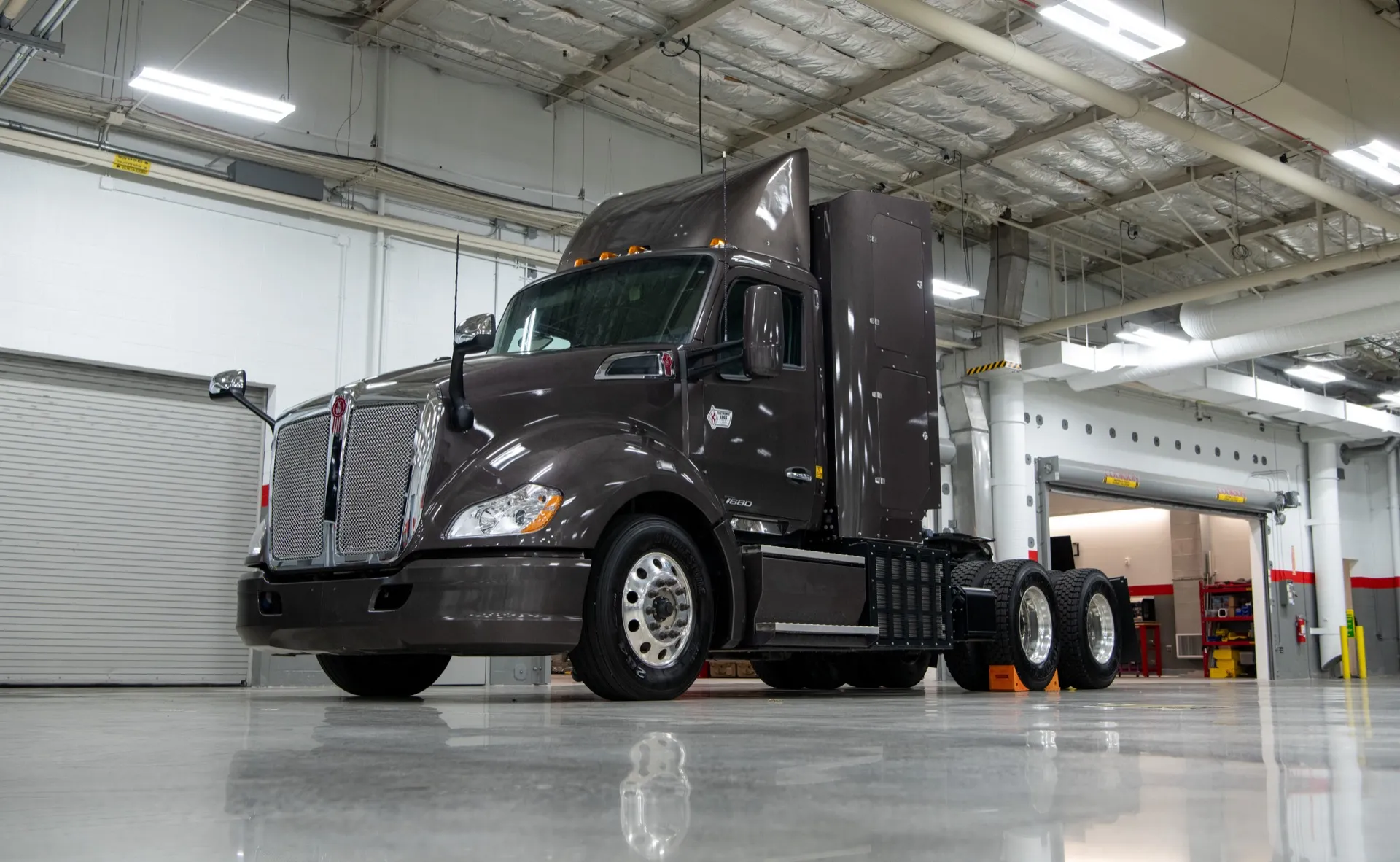In its latest production-bound version of hydrogen fuel-cell semis, Toyota is adding much more of something that will help it go the distance consistently: batteries.
Hydrogen fuel cell power is often seen as an alternative to batteries, but here the latter makes the former better. Toyota has opted to fit 200 kwh of lithium-ion NCA (nickel cobalt aluminum) battery cells in the special hydrogen fuel-cell Kenworth T680 set to be showcased at the Advanced Clean Transportation (ACT) Expo later this month.
It’s a formula that may serve as a template for the future for making hydrogen fuel-cell commercial vehicles viable, and as Toyota executives underscored this past week, the batteries are a necessary piece to create an effective regional-use fuel-cell semi.
Kenworth-Toyota fuel-cell semi with 200-kwh battery pack
Such a big battery pack isn’t needed the vast majority of the time, but it gives this format a lot more flexibility. This huge Class 8 semi is an evolution of the hydrogen fuel-cell semis that Toyota and Kenworth have tested in prototype form for years with port duty and local runs, and with this change the semi is now good for regional runs: up to 82,000 pounds of payload and a target 300 miles no matter what the terrain—or up to 450 miles on calmer terrain.
Batteries are always used as an energy buffer with fuel-cell stacks, which take some time to ramp up and are best producing a steady power output. Having a much larger battery pack on board helps ultimately boost the efficiency of this semi’s fuel-cell stack, Toyota said, and the battery pack potentially allows a great amount of energy recovery on steeper downgrades.
In its latest version, this specially fitted Kenworth T680 can comfortably get from Long Beach, California, over the infamous Interstate 5 Grapevine, at speed, with a full load, to Barstow and back—nearly 270 miles—without needing to ever worry about being refueled.
Up to 450 miles of range on a hydrogen fill
The latest prototype produces 415 hp of continuous power through a 310-kw dual-motor system, and it returns an official range of up to 450 miles from its 58.8 kg of hydrogen. It’s set to be powered by a modularized kit built on the current Gen 2 stack that’s used in the Toyota Mirai. The module will be put together by Toyota in Kentucky and offered to a range of companies—although the fuel cells themselves will still come from Japan.
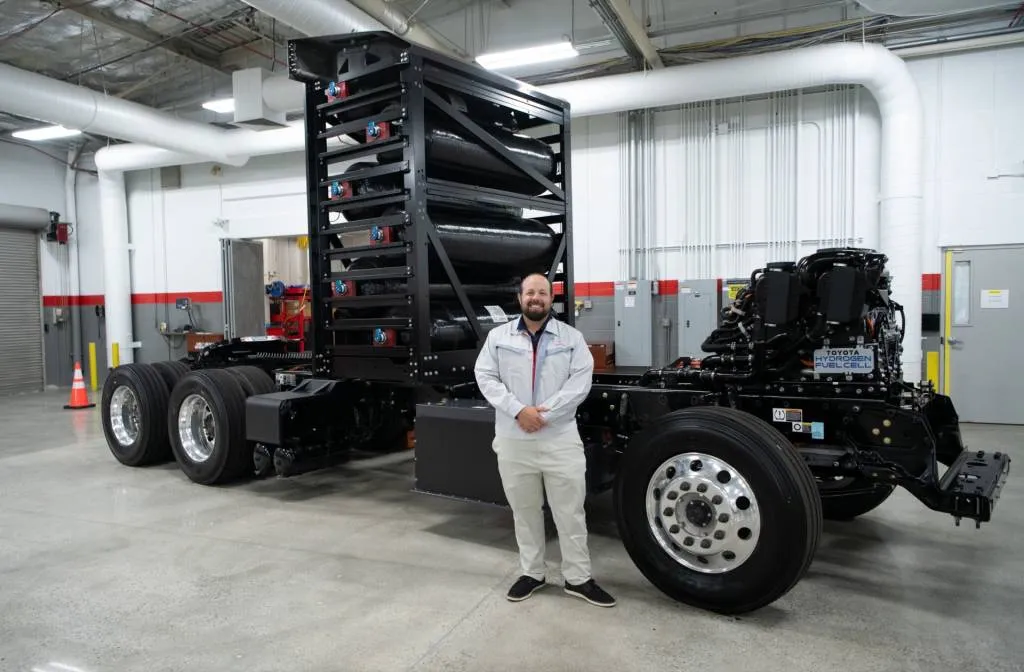
Kenworth-Toyota hydrogen fuel-cell semi prototype. – May 2024
The new configuration essentially results from Toyota listening to the truck’s potential commercial customers, and addressing their direct needs, explained Scott Friedman, the senior program manager at Toyota North America tasked with the fuel-cell semi’s powertrain integration. Batteries and module aside, the layout of the previous port trucks carries mostly over to this new prototype.
The dual-motor system, the transmission, and overall integration are Toyota responsibilities in addition to the fuel-cell module itself. The battery packs ride side-saddle, mounted somewhat low on the cab pretty close to where the fuel tanks would be, while the large hydrogen tanks are a lot lighter and mounted higher up, occupying what would otherwise be the sleeper.
Big battery, no charge port
Toyota isn’t planning to charge this semi through any means other than the fuel-cell stack, and there’s no charge port, according to Friedman. So the battery pack amounts to a giant buffer that, it seems, could and will be used smartly by fleet management software. “We don’t want our trucks to have to go to a battery stop and a hydrogen stop,” Friedman said.
“We developed it based on duty cycles and customer expectations, and that’s kind of the scope,” summed Friedman. “You can easily adapt this,” he added, after a pause when pressed about whether a charge port could be added for a customer who, for instance, did want that capability.
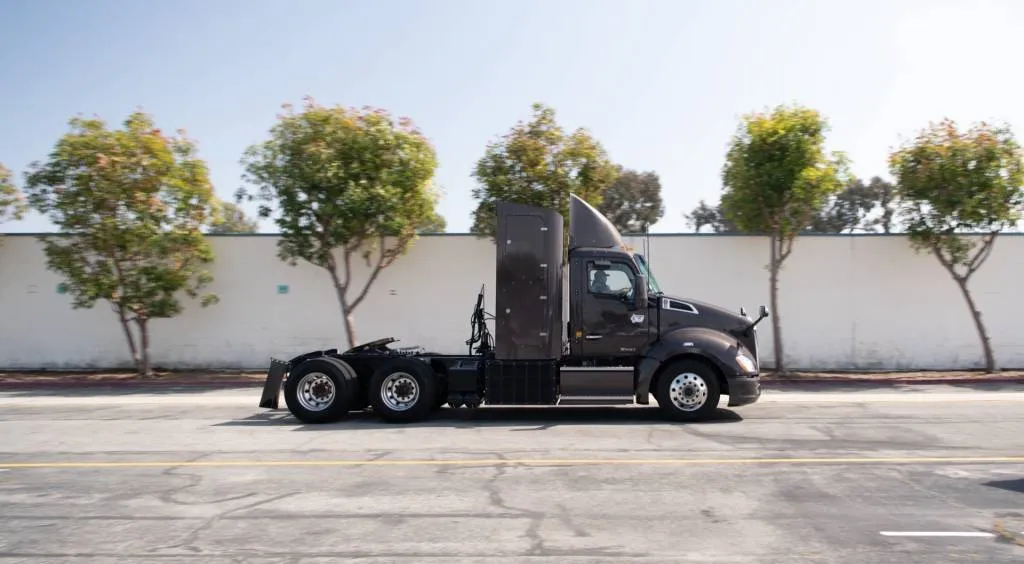
Kenworth-Toyota hydrogen fuel-cell semi prototype. – May 2024
Toyota has likely mapped out the possibilities already. It has a heavy-duty testbed at its center for hydrogen development (H2HQ) in Gardena, including a dyno rated to 1.2 megawatts of power to keep in mind the kinds of applications it may prepare in the future.
In a tour of H2HQ last week, Toyota executives dropped plenty of hints that it’s working on hydrogen fuel-cell pickups. It even has a working fuel-cell Tundra prototype in Japan that it uses to tow its hydrogen combustion-engine race car. And that’s in addition to a Hilux hydrogen fuel-cell prototype pickup in the U.K.
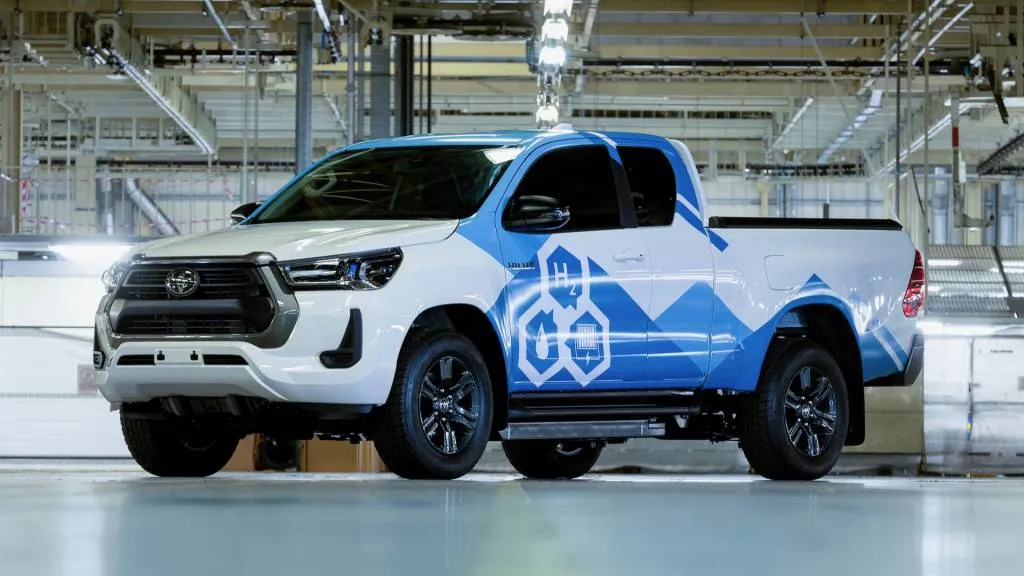
Toyota Hilux hydrogen fuel-cell prototype
Toyota presented an unexpectedly straightforward reason for bypassing chargers in passenger vehicles: Adding a charge port disincentivizes the buildout of the hydrogen network.
Speaking to Green Car Reports in late 2019, Mirai chief engineer Yoshikazu Tanaka told us that to grow the hydrogen infrastructure you needed to consume it; if customers started charging at home then they wouldn’t consume (and depend on) the hydrogen.
But it’s different for trucks, argued Jay Sackett, the former Toyota Tundra chief engineer now working directly with fuel cells as chief engineer for advanced mobility. Just as Toyota steps up the battery size for its fuel-cell semi but doesn’t add a charge port, Toyota doesn’t see a lot of use for the charge port on a pickup.
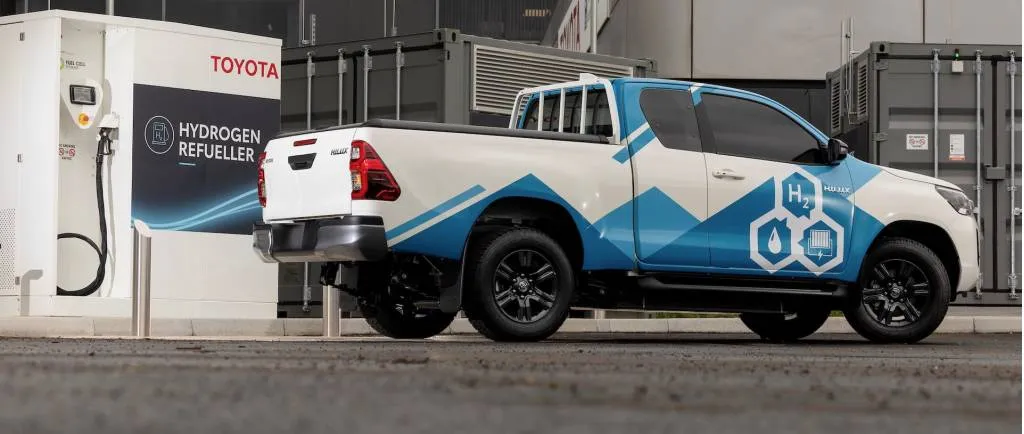
Toyota Hilux hydrogen fuel-cell prototype
If Toyota makes a fuel-cell truck, Sackett suggested to Green Car Reports, it would be one oriented toward those who frequently tow or truly use the capability of the truck—and charging and towing simply don’t work together, he said. And its Tundra customers tow frequently.
In short, Sackett summed, it’s a matter of time and consistency—and energy density. You can get a 20-minute refuel of hydrogen, good for hundreds of miles even when towing. But charging the kind of battery needed for that kind of range remains a serious hurdle today.
Responding to several prompts about how this might be put to use in the real world, Sackett made no confirmation that plug-in capability was something the company was seriously considering. Yet Sackett pointed to the semi project and its bigger battery buffer as a template for what works in a predictable commercial or fleet situation, where fueling stations are established.
Perhaps that would be around one of the hydrogen hubs that are set to be federally funded with $8 billion.
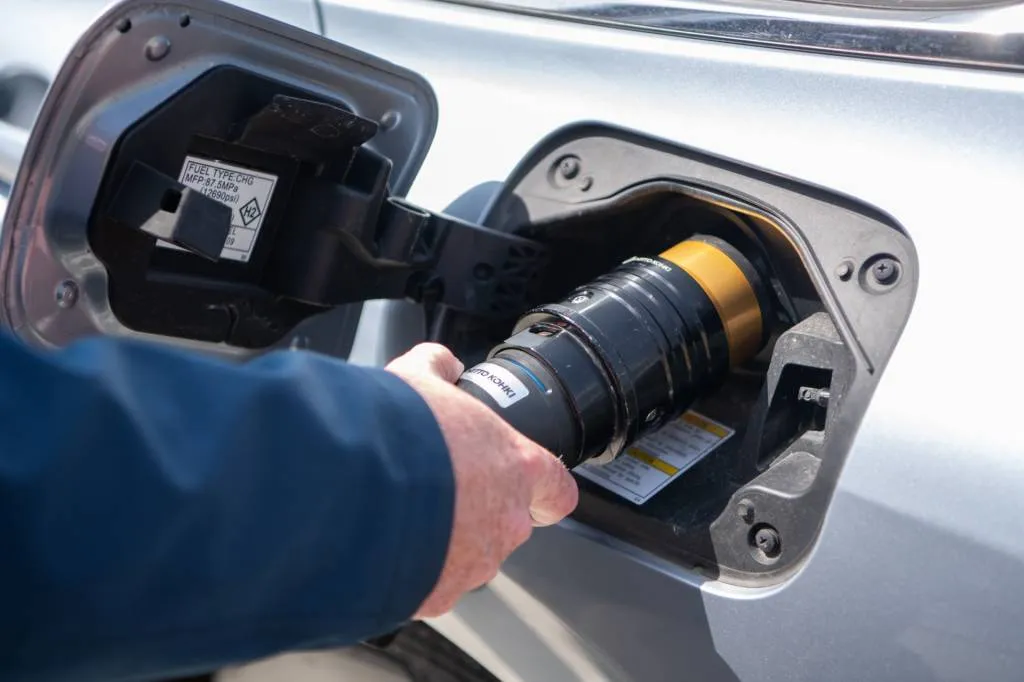
Hydrogen fueling at Toyota H2HQ
Still the same hydrogen fueling challenges
This also more closely aligns with other formulas used in the industry—such as that of the Nikola Tre, which packs 200 kw of fuel-cell power modules with 164 kwh of battery energy. Nikola this week announced its second HYLA fueling station in California, near the Port of Long Beach. It’s due to create 60 hydrogen stations by 2026, aided by incentives.
The port itself is the home of Toyota’s Tri-Gen facility, which takes Toyota’s biggest U.S. port off the grid, generating 2.3 megawatts of electricity daily from natural gas made renewable through credits via methane generated at Orange County Sanitation. It also generates up to 1,200 kg of hydrogen per day—to be used for fueling hydrogen vehicles—along with 1,400 gallons of water per day that can be used to wash vehicles arriving at port.
While the carbon portion of the calculation requires a litany of hypotheticals and what-ifs, what does or doesn’t come out of such fuel-cell solutions, as semis or pickups, is far more straightforward. If it’s covering solutions that don’t yet practically work with batteries alone, with a solution that is rid of the smog-forming emissions and particulates of diesel exhaust, why not?

